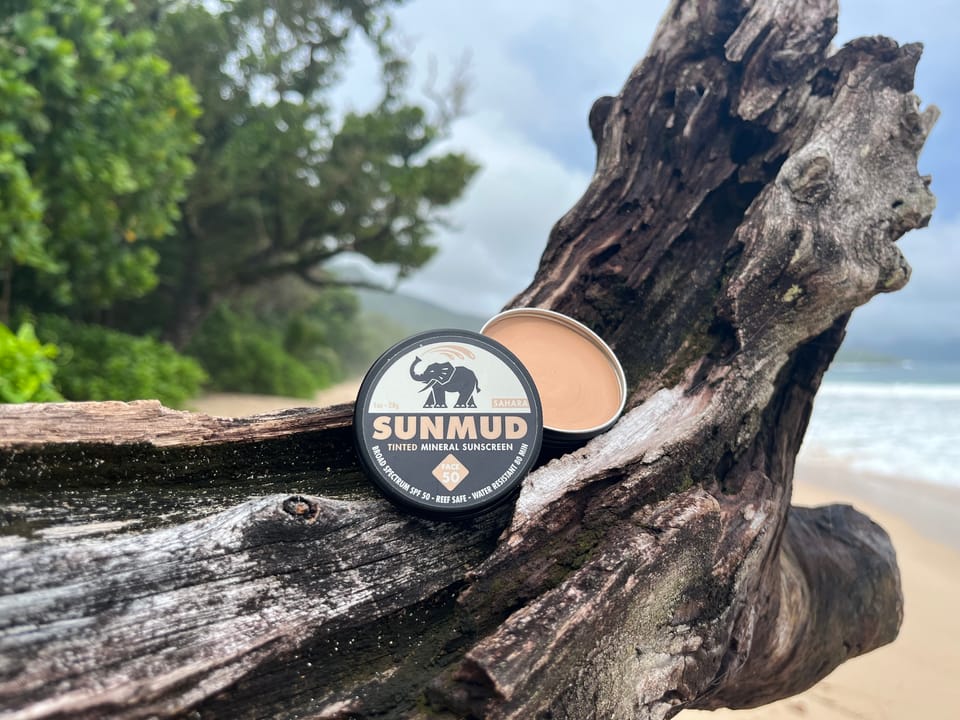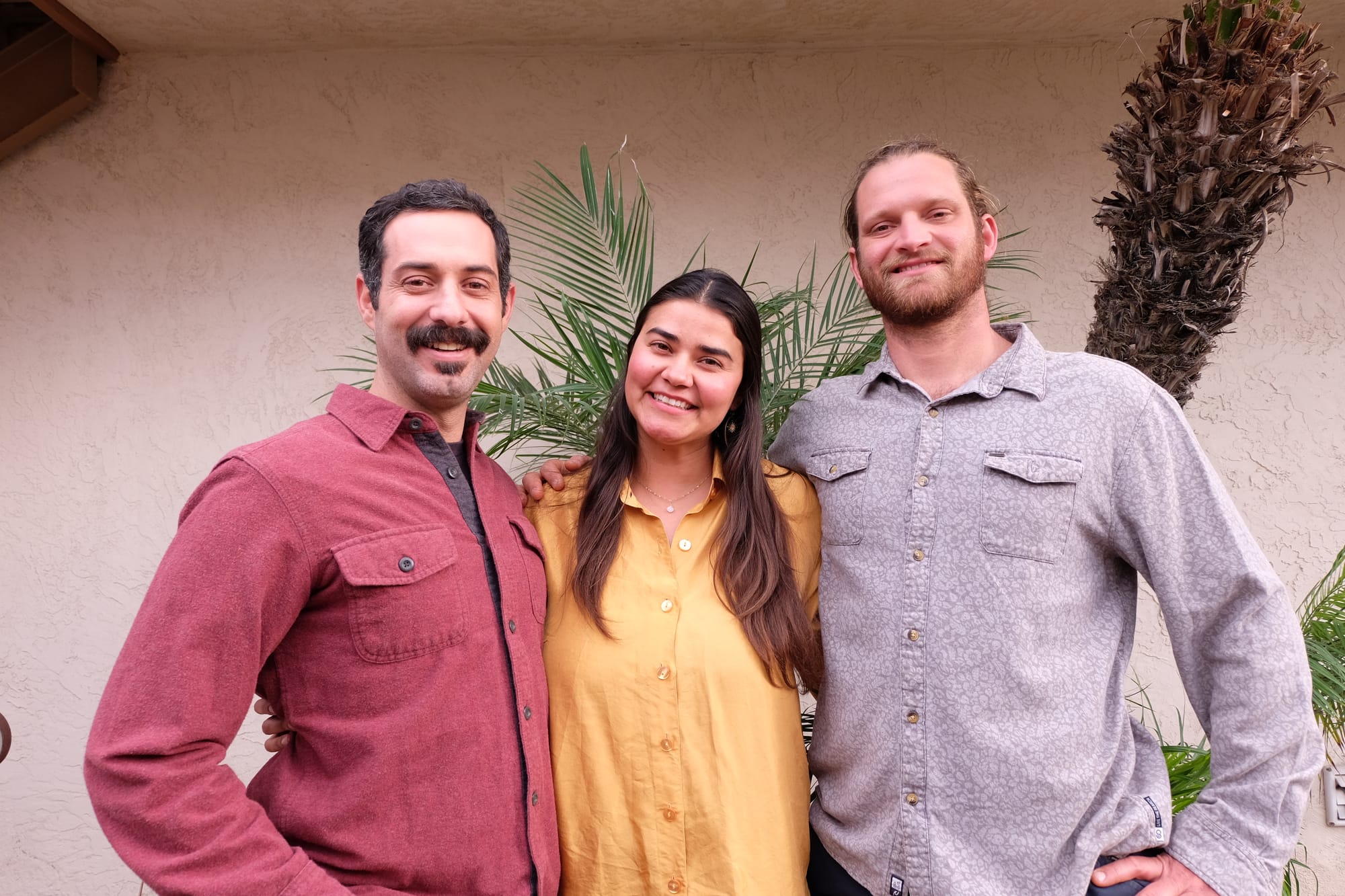Basking in SUNMUD Safeguards Earth’s Oceans

By Rise Riyo, Community Outreach Manager
As a GenX kid growing up along the coast of Southern Cal, I remember an image of a little blue-eyed girl with curly blonde pigtails, glancing over her bareskin shoulder, astonished to see a mischievous pup tugging at her bikini bottoms, just enough to reveal her suntanned torso contrasting against a milky white toned tush. This iconic pop culture image, the Coppertone girl, became a prominent part of the Coppertone brand capturing a carefree, “healthy” lifestyle of beach culture from the early 1940s and on.[1] Their marketing campaign encouraged American society, no matter where one lived, to bask in the sun for hours on end, just to attain that ideal look.
But while Americans leisurely sunbathed, U.S. health professionals began to see a rise in various skin cancers among the population over time. Although research studies showed that there was a relation between sun exposure and skin cancer,[2] there wasn’t a lot of information outlining the risks of overexposure in the sun available to the public.
By the late 1970s, the transition from marketing tanning lotions to marketing sunscreen and sunblock products was slowly being adopted by a few companies and introduced to consumers at an even slower rate. Sunscreen and sunblock products were respectively made to absorb or block UVA and UVB light rays from entering human skin. The majority of suncare products were still aimed at sun tanning as an activity compared to alternative sunscreen and sunblock options for consumers.
In 2015, research scientists were able to prove that overexposure to sunlight caused UV radiation damaging the DNA that led to skin cancers.[3] Yet, many personal suncare products on the market, that may have prevented sunburn, skin cancer, and photoaging of human skin, contained chemicals that have known side effects that are toxic to humans.
Concerned consumers began to point out the use of these chemicals and looked for other options to the so-called "alternatives" to tanning. In some cases, consumers ended up handcrafting their own products with the exclusion of ingredients that they deemed toxic. A few products evolved into the formation of companies to meet community-based needs. One such company is SUNMUD, a sustainable suncare products company.
“We never really intended to become a sunscreen company,” explained Charles Biset. “It wasn’t like, seven years ago, where we were like, ‘Let’s become a sunscreen company.’” Biset is an aerospace engineer and one of three founders of SUNMUD. It was several years ago that Charles and his life partner, Maricruz Carrillo, a materials scientist, traveled to Puerto Escondido, a port town on Mexico’s Pacific side, with their friends for a surfing trip. Not happy with the numerous sunscreen and sunblock products available to U.S. consumers, Maricruz, who has a PhD in bioengineering, began to dabble with natural, non-toxic ingredients that were healthier for her, Charles, and their friends.
Carrillo avoided using oxybenzone and octinoxate, two known ingredients that were used in many suncare products at that time. These chemicals cause serious side effects such as skin allergies, eye irritants, swelling in the throat, difficulty with breathing, and dizziness.[4] Other research has shown that oxybenzone and octinoxate are also harmful to reproductive organ development of fetuses exposed in utero.[5]
In 2016, a research study revealed that oxybenzone and octinoxate also harm the flora and fauna of coral reefs.[6] In 2018, former Governor David Ige of Hawaii signed a bill, SB 2571, that banned the sale of consumer products containing these chemicals as ingredients to prevent further destruction to the coral reefs off the coasts of the archipelago. Thus, Hawaii became the first state to ban these two chemicals. “Conventional sunscreens, the non-mineral sunscreens, are bleaching the reefs [by] preventing photosynthesis,” explained Charles.
By removing harmful ingredients from their product, Maricruz eventually created the first iteration of an eco-friendly suncare product that she, Charles, and their circle of friends began to use when out on the ocean. After receiving much positive feedback from friends and other fellow surfers, a childhood friend of Charles, Miles Lee, decided to run with Maricruz’ formula by taking it to the next level.
Miles, a savvy entrepreneur and third founder of SUNMUD, began perfecting the product by using other natural ingredients such as adding Multani Mitti clay to the mixture and using organic jojoba liquid wax, which moisturizes the skin and does not oxidize or become rancid like coconut oil. Miles also worked on improving the tints to better match the hue of human skin tone. Charles stated, “It sounds simple, but it’s actually really challenging” given the myriad skin tones that humans have. Furthermore, Lee dived into researching what was safer beyond the greenwashing use of the phrase “reef-safe” by opting to use the non-nanoparticles of mineral ingredients such as zinc oxide.
A nanoparticle, as defined by the Environmental Protection Agency (EPA), is an ultrafine particle of matter 1 to 100 nanometers in size in regards to air pollution control.[7] Nanomaterials have increased in number and are primarily used in many consumer products. Nanoparticles of mineral ingredients have been shown to be toxic to skin cells. If inhaled, lungs have trouble clearing the nanoparticles, which have the potential of passing from the lungs into the bloodstream. And if ingested, the potential of absorption into the bloodstream can occur affecting normal gut physiologic, metabolic, and immune function.[8]
In like manner to plastic waste, nanoparticles are detrimentally impacting the fauna and flora of earth’s oceans. As humans apply suncare products with nanoparticle ingredients onto the skin, the nanomaterials rinse off into the water, becoming mixed in with ocean sediment and onto sandy beaches. They have been found in bottom feeders such as crustaceans[9] and filter feeders such as mussel and oysters[10], and “are a contributing factor for coral reef bleaching,” added Charles.
The evolving composition of SUNMUD's products was based on initial sets of data gathered from local communities to which the SUNMUD team belong. “We interviewed over 150 surfers first,” stated Charles, “Then other athletes in the triathlete space about their sunscreen habits.” The early adopters became the surfing community, and afterwards, the natural food and sustainability communities. Charles mentioned that they continued to make little tweaks here and there to their suncare formula, but, more importantly, the founders made sure that they were providing the right benefits to the end user.
Indeed, the founders of SUNMUD hold true to their values using certified organic, sustainably sourced, fair trade ingredients, and aluminum containers which are easier to recycle than glass containers and are infinitely recyclable. The team are currently looking into digital printing as a way of avoiding using labels. Staff member, Alizee Accomando, has been the team’s graphic and brand designer. All designs have been printed with plant-based inks so getting the design onto the aluminum container using digital printing can be challenging with the type of inks that the printer business uses.
The founders decided to sell their suncare products on Etsy, an eCommerce website, which claims to cater to artisans and their handmade products. It’s been a learning experience according to Charles. How does one scale their business while remaining commited to the quality of the product, maintaining close ties to local, supportive communities, and protecting the earth’s oceans and environment for future generations? For any business challenges exist, but the founders’ commitment to safeguarding the earth's oceans remains intact by volunteering for beach cleanups with Surfrider Foundation to selling at local, small sustainability fairs to purchasing quality organic ingredients from fair trade suppliers. It’s not every day that one finds a rare pearl in a vast sea of companies whose interests are more centered on profiting from sales than safeguarding the health and well-being of consumers and of the oceans. SUNMUD is that rare pearl for me.
SunMud website: /https://sunmudsunscreen.com/
Instagram: @sunmud.sunscreen
Email: hello@sunmudsunscreen.com
Coppertone (sunscreen). Wikipedia. Retrieved on 11 July 2024 from https://en.wikipedia.org/wiki/Coppertone_(sunscreen). ↩︎
Driss, Madeeha, Emily Carr and Chadhouswright. “Sunscreen: A brief walk through history.” Proc (Bayl Univ Med Cent). 2022; 35(1): 121-123. Retrieved on 11 July 2024 from https://www.ncbi.nlm.nih.gov/pmc/articles/PMC8682817/. ↩︎
Brash, Douglas E., “UV mutations”, Photochemistry and Photobiology, 2015 Jan-February, 91(1); pp. 15-26, Retrieved 11 July 2024 from https://pubmed.ncbi.nlm.nih.gov/25354245/. ↩︎
Suh, Susie et al. The Banned Sunscreen Ingredients and Their Impact on Human Health: A Systematic Review. International Journal of Dermatology. 2020 Sept: 59(9); 1033-1042. Retrieved on 11 July 2024 from https://www.ncbi.nlm.nih.gov/pmc/articles/PMC7648445/. ↩︎
Octinoxate. Campaign for Safe Cosmetics. Retrieved 11 July 2024 from https://www.safecosmetics.org/chemicals/octinoxate/#:~:text=Reproductive organs and development toxicity,female fetuses exposed in utero. ↩︎
Downs, C.A. Esti Kramarsky-Winter et al. “Toxicopathological Effects of the Sunscreen UV Filter, Oxybenzone (Benzophenone-3), on Coral Planulae and Cultured Primary Cells and Its Environmental Contamination in Hawaii and the U.S. Virgin Islands”. Arch Environ Contam Toxicol 70, 265–288 (2016). Retrieved on 11 July 2024 from https://doi.org/10.1007/s00244-015-0227-7. ↩︎
“Module 3: Characteristics of Particles – Particle Size Categories”. Environmental Protection Agency. Retrieved on 11 July 2024 from https://web.archive.org/web/20101203205130/http://www.epa.gov/apti/bces/module3/category/category.htm . ↩︎
Bergin, Ingrid L. and Frank A. Witzmann. “Nanoparticle toxicity by the gastrointestinal route: evidence and knowledge gaps”. International Journal of Biomedical Nanoscience and Nanotechnology. 2013; 3(1-2). Retrieved on 11 July 2024 from https://www.ncbi.nlm.nih.gov/pmc/articles/PMC3822607/#:~:text=Potential outcomes of ingestion of,layer and the GIT microbiome%2C . ↩︎
Norwegian Institute for Water Research (NIVA). "Nanomaterials in wastewater have toxic effects on crustaceans and fish". 2019 18 November. Retrieved on 11 July 2024 from https://phys.org/news/2019-11-nanomaterials-wastewater-toxic-effects-crustaceans.html#:~:text="Daphnia magna is an organism,by solid-associated nanoparticles." . ↩︎
Buckley, Christine. “Study Examines How Nanoparticles Affect Marine Organisms”. UConn Today. February 22, 2010. Retrieved on 11 July 2024 from https://today.uconn.edu/2010/02/study-examines-how-nanoparticles-affect-marine-organisms/# . ↩︎

